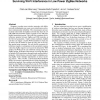Free Online Productivity Tools
i2Speak
i2Symbol
i2OCR
iTex2Img
iWeb2Print
iWeb2Shot
i2Type
iPdf2Split
iPdf2Merge
i2Bopomofo
i2Arabic
i2Style
i2Image
i2PDF
iLatex2Rtf
Sci2ools
129
click to vote
SENSYS
2010
ACM
2010
ACM
Surviving wi-fi interference in low power ZigBee networks
Frequency overlap across wireless networks with different radio technologies can cause severe interference and reduce communication reliability. The circumstances are particularly unfavorable for ZigBee networks that share the 2.4 GHz ISM band with WiFi senders capable of 10 to 100 times higher transmission power. Our work first examines the interference patterns between ZigBee and WiFi networks at the bit-level granularity. Under certain conditions, ZigBee activities can trigger a nearby WiFi transmitter to back off, in which case the header is often the only part of the ZigBee packet being corrupted. We call this the symmetric interference regions, in comparison to the asymmetric regions where the ZigBee signal is too weak to be detected by WiFi senders, but WiFi activity can uniformly corrupt any bit in a ZigBee packet. With these observations, we design BuzzBuzz to mitigate WiFi interference through header and payload redundancy. Multi-Headers provides header redundancy giving Zig...
Sensor Networks | SENSYS 2010 | WiFi | WiFi Senders | Zigbee |
Related Content
| Added | 15 Feb 2011 |
| Updated | 15 Feb 2011 |
| Type | Journal |
| Year | 2010 |
| Where | SENSYS |
| Authors | Chieh-Jan Mike Liang, Bodhi Priyantha, Jie Liu, Andreas Terzis |
Comments (0)

